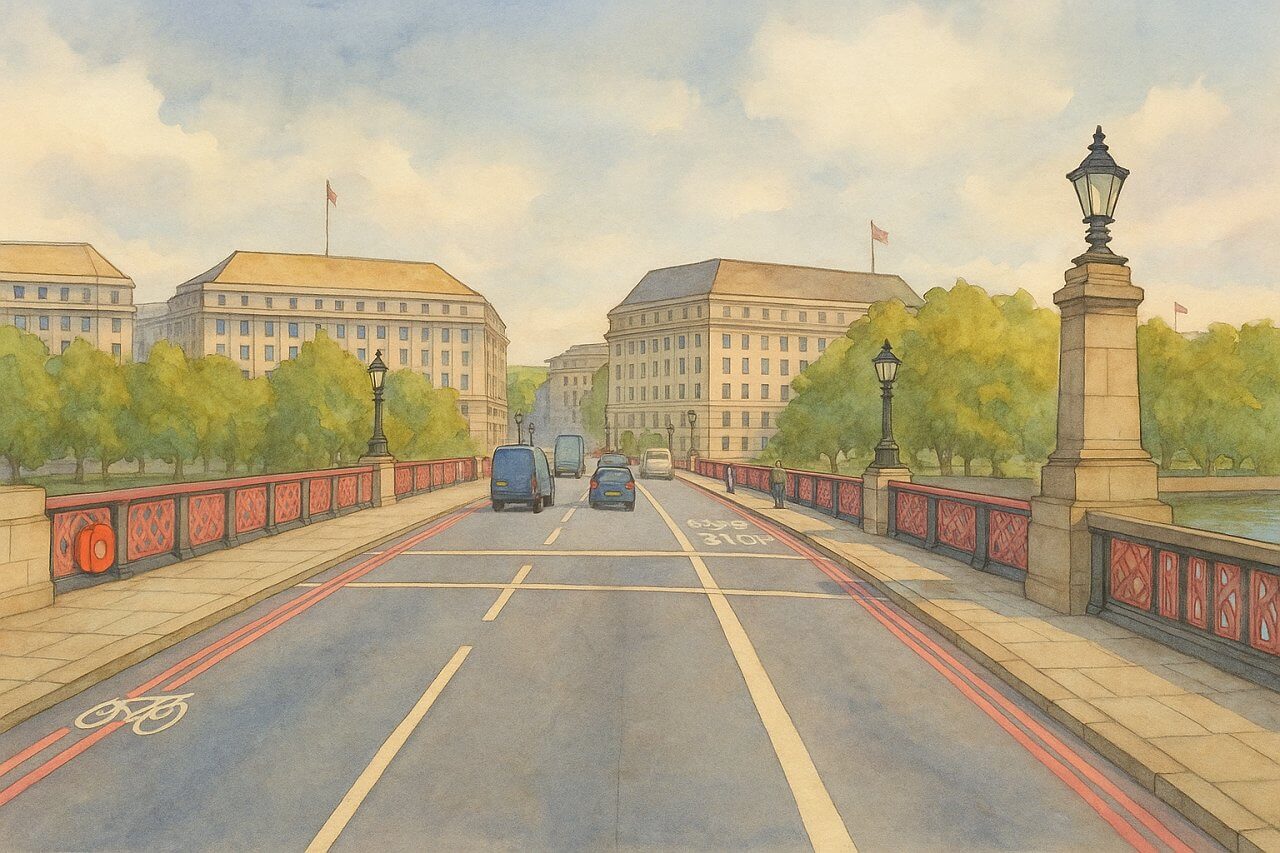
Lambeth Bridge, London
Lambeth Bridge, London - History, Colour, and Curiosities
Lambeth Bridge is a road traffic and pedestrian bridge that spans the River Thames in central London.It links the London Borough of Lambeth on the south side of the river to the City of Westminster on the north side, connecting two historically significant parts of the city.
On the southern end, it meets the Albert Embankment and Lambeth Palace Road. To the north, it feeds into Horseferry Road and Millbank, placing it just a short walk from the Houses of Parliament and Westminster Abbey.
This strategic location makes Lambeth Bridge not only a key crossing point but also an attractive walk for those exploring the heart of London.
Length, History, and Construction
Lambeth Bridge is approximately 236 metres (774 feet) long and 20 metres (66 feet) wide, making it one of the shorter central London bridges but still significant due to its location and design.The current bridge was opened in 1932, replacing an older suspension bridge that dated back to 1862.
The replacement was needed due to the old structure's inability to accommodate increasing vehicular traffic.
The present-day bridge was designed by Sir George Humphreys, the then Chief Engineer of the London County Council, in collaboration with architect Sir Reginald Blomfield.
Its construction was carried out by Dorman Long, the same engineering company that worked on the iconic Sydney Harbour Bridge.
The design of Lambeth Bridge is a blend of functionality and symbolism, combining a five-arch steel structure with Art Deco-style stonework and balustrades.
The Bold Red Colour and Its Symbolism
One of the most striking features of Lambeth Bridge is its bold red colour.This is not simply a stylistic choice—it was selected to symbolise the House of Lords, whose seats in the nearby Palace of Westminster are upholstered in red leather.
The bridge's red paint complements the green colour of Westminster Bridge, located just upstream, which represents the green benches of the House of Commons.
This deliberate colour coding reflects the positioning of the two bridges: Lambeth Bridge is closer to the House of Lords (the southern end of the Palace of Westminster), while Westminster Bridge is nearer to the House of Commons.
This system serves as a subtle but clever visual metaphor for Britain's parliamentary structure.
It's worth noting that the original colour of the bridge was not as distinct. The current vivid red is the result of repainting efforts carried out in the late 20th century to reinforce its symbolic association.
How Did Lambeth Bridge Get Its Name?
The name "Lambeth Bridge" derives from the Lambeth area on the southern side of the River Thames.The name "Lambeth" is believed to come from the Old English words lamb (a young sheep) and hythe (a landing place or port), thus meaning “a landing place for lambs.”
This etymology reflects the area's medieval role as a riverside market and landing place.
The bridge has carried the name Lambeth Bridge since the first crossing was built here in the 19th century.
The 1932 bridge retained the name in recognition of its geographical location and its historical continuity.
Roads That Connect to Lambeth Bridge
Lambeth Bridge serves as a key traffic route between the north and south banks of the Thames.On the south side, it connects to:
- Lambeth Palace Road
- Albert Embankment
Nearest Underground Stations
Lambeth Bridge is well-served by several London Underground stations:- Westminster Station – on the Jubilee, District, and Circle lines. Approximately a 10–12 minute walk from the north end of the bridge.
- Lambeth North Station – on the Bakerloo line. About 10 minutes on foot from the south end.
- Vauxhall Station – on the Victoria line and National Rail services. A 15-minute walk along the Albert Embankment.
Fun Facts About Lambeth Bridge
Lambeth Bridge is full of curious features and historical details that may surprise even Londoners.- At each end of the bridge stand four obelisk-like stone piers topped with pinecone-shaped finials. Many people believe these are pineapples, a symbol of hospitality, and a nod to John Tradescant, a 17th-century gardener who lived in Lambeth and was among the first to grow a pineapple in England.
- The bridge was used in the film Harry Potter and the Prisoner of Azkaban when the purple triple-decker Knight Bus squeezes between two red double-decker buses crossing the bridge.
- Lambeth Bridge is one of the few bridges in London with a weight restriction (currently 18 tonnes), making it unsuitable for heavier vehicles like lorries and buses, which helps preserve its structure.
- Unlike other London bridges, it has no piers in the water; the support is entirely above the river, giving it a clean silhouette and making it less prone to collecting debris from the Thames.
Quick Facts About Lambeth Bridge
- Location: Crosses the River Thames between Lambeth and Westminster
- Length: 236 metres (774 feet)
- Opened: 1932 (replacing a suspension bridge from 1862)
- Designers: Sir George Humphreys and Sir Reginald Blomfield
- Colour: Red, symbolising the House of Lords
- Connecting Roads: Lambeth Palace Road, Albert Embankment, Millbank, Horseferry Road
- Nearest Tube Stations: Westminster (Jubilee, District, Circle), Lambeth North (Bakerloo), Vauxhall (Victoria)
- Fun Fact: Believed to feature pineapple-shaped finials and appeared in a Harry Potter film
A Symbolic and Scenic Crossing
Lambeth Bridge may not attract the same crowds as its neighbour, Westminster Bridge, but it holds a quiet significance in London’s story.From its deep red paint representing the House of Lords to its elegant Art Deco details, it serves as a reminder that even utilitarian structures can be rich with symbolism and style.
Whether you're a curious tourist crossing the Thames or a Londoner seeking a scenic route between two boroughs, Lambeth Bridge is well worth a closer look.
Map of Lambeth Bridge, London

Painting of Lambeth Bridge, London (View image in full size)